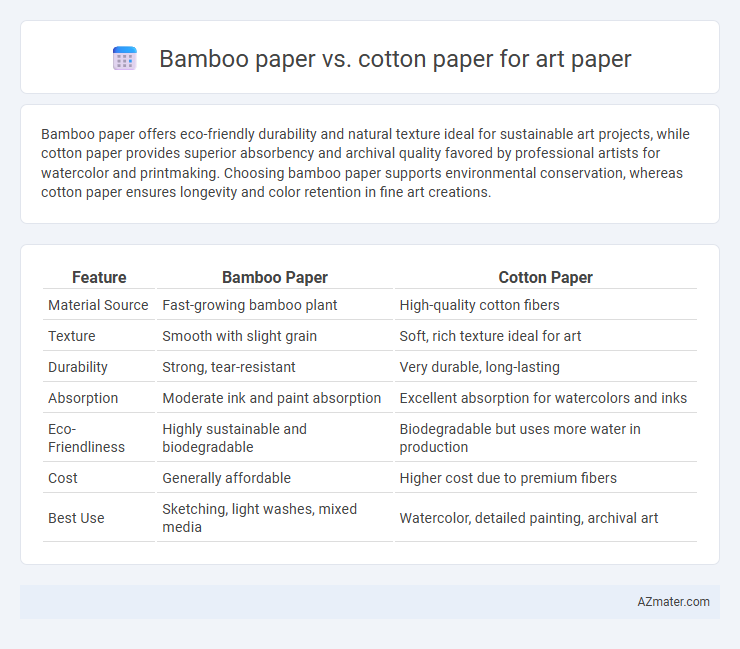Bamboo paper offers eco-friendly durability and natural texture ideal for sustainable art projects, while cotton paper provides superior absorbency and archival quality favored by professional artists for watercolor and printmaking. Choosing bamboo paper supports environmental conservation, whereas cotton paper ensures longevity and color retention in fine art creations.
Table of Comparison
| Feature | Bamboo Paper | Cotton Paper |
|---|---|---|
| Material Source | Fast-growing bamboo plant | High-quality cotton fibers |
| Texture | Smooth with slight grain | Soft, rich texture ideal for art |
| Durability | Strong, tear-resistant | Very durable, long-lasting |
| Absorption | Moderate ink and paint absorption | Excellent absorption for watercolors and inks |
| Eco-Friendliness | Highly sustainable and biodegradable | Biodegradable but uses more water in production |
| Cost | Generally affordable | Higher cost due to premium fibers |
| Best Use | Sketching, light washes, mixed media | Watercolor, detailed painting, archival art |
Introduction to Art Paper Choices
Bamboo paper and cotton paper are two popular art paper choices, each offering unique textures and durability suited for different artistic styles. Bamboo paper is eco-friendly, made from fast-growing bamboo fibers, providing a smooth surface ideal for ink and watercolor applications. Cotton paper, known for its superior absorbency and archival quality, remains a preferred option for artists requiring longevity and rich texture for mediums like charcoal and acrylics.
Overview of Bamboo Paper
Bamboo paper offers exceptional sustainability with its fast-growing, renewable bamboo fibers, making it an eco-friendly alternative to traditional cotton paper for artists. It provides a smooth texture that holds ink and paint well, ideal for watercolor, ink, and sketching applications. Bamboo paper is highly durable and resistant to tearing, ensuring longevity and stable performance in various art projects.
Overview of Cotton Paper
Cotton paper, crafted from 100% cotton fibers, offers exceptional durability and archival quality, making it a preferred choice for artists seeking longevity and texture in their artworks. Its natural absorbency and softness provide superior support for various mediums, including watercolor, ink, and charcoal, ensuring vibrant color retention and detail precision. Compared to bamboo paper, cotton paper typically exhibits greater thickness and resilience, enhancing its suitability for professional-grade fine art and printmaking projects.
Texture and Surface Differences
Bamboo paper features a smooth, consistent texture with fine fibers that create a slightly glossy surface ideal for detailed ink work and light washes. In contrast, cotton paper offers a more textured, absorbent surface with natural irregularities, providing excellent grip for heavier media like charcoal, pastels, and acrylics. Artists seeking crisp lines and minimal bleeding prefer bamboo paper, while those requiring robust absorption and surface tooth favor cotton paper.
Absorbency and Paint Handling
Bamboo paper offers high absorbency, quickly soaking up watercolors and allowing for smooth, effortless blending, which benefits artists working with wet media. Cotton paper provides superior paint handling, retaining moisture evenly and enabling more extended working times without warping or bleeding, ideal for detailed brushwork. Both papers cater to different techniques; bamboo excels in fast drying and texture, while cotton ensures durability and precision in paint application.
Environmental Impact and Sustainability
Bamboo paper offers a highly sustainable alternative to cotton paper due to bamboo's rapid growth cycle and minimal need for pesticides, reducing deforestation and chemical runoff significantly. Cotton paper production is resource-intensive, requiring large amounts of water and energy, making it less eco-friendly despite its durability and texture favored by artists. Choosing bamboo paper supports sustainable forestry practices and lowers carbon footprint in art paper manufacturing, aligning with environmentally conscious art practices.
Archival Quality and Longevity
Bamboo paper offers excellent archival quality due to its natural lignin-free fibers, ensuring resistance to yellowing and brittleness over time, making it highly durable for art preservation. Cotton paper, composed of at least 25% cotton rag content, is widely regarded for superior longevity and strength, as it resists deterioration from acids and environmental factors. Both papers support high archival standards, but cotton paper remains the preferred choice among artists and conservators for long-term artwork preservation owing to its proven stability and resilience.
Cost Comparison
Bamboo paper is generally more cost-effective than cotton paper, with prices typically 20-30% lower due to faster bamboo growth and sustainable harvesting methods reducing raw material costs. Cotton paper, favored for its durability and archival quality, often commands a premium price, making it a more expensive choice for artists seeking long-lasting media. Budget-conscious artists might prefer bamboo paper for everyday practice, while cotton paper is reserved for final, high-quality projects where longevity justifies the investment.
Popular Uses in Art Mediums
Bamboo paper is favored in watercolor and ink art for its smooth texture and eco-friendliness, offering excellent absorbency and durability, which makes it ideal for wash techniques and calligraphy. Cotton paper, widely used in fine art, excels in oil painting and dry mediums like pastels and charcoal due to its robust fiber structure, providing superior archival quality and resistance to warping. Both papers support mixed media applications, but artists often choose cotton for longevity and bamboo for sustainable practices.
Choosing the Right Paper for Your Artwork
Bamboo paper offers a sustainable and eco-friendly option with a smooth texture ideal for detailed ink and watercolor work, while cotton paper provides superior durability and archival quality favored by professional artists for oil and acrylic paintings. Cotton fibers contribute to excellent absorbency and longevity, making it suitable for artworks that require strength and preservation over time. Selecting between bamboo and cotton paper depends on the medium, desired texture, and environmental considerations critical for achieving the best artistic results.

Infographic: Bamboo paper vs Cotton paper for Art paper
 azmater.com
azmater.com